University welcomes HRH The Earl of Wessex
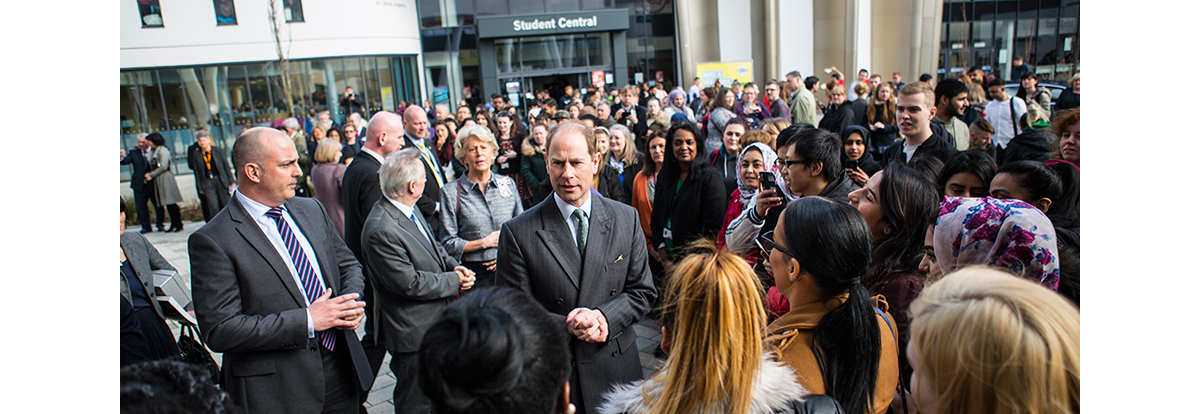 Photos courtesy of Roger V Moody and Alex Beldea Photography
Photos courtesy of Roger V Moody and Alex Beldea Photography
Fri, 10 Mar 2017 15:32:00 GMT
The Royal Visitor viewed both ancient and modern before visiting the future
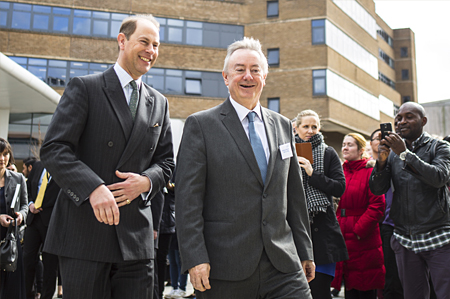 ◄ HRH The Earl of Wessex was welcomed to the campus by the University’s Vice-Chancellor, Professor Bob Cryan (right)
◄ HRH The Earl of Wessex was welcomed to the campus by the University’s Vice-Chancellor, Professor Bob Cryan (right)
WHEN HRH The Earl of Wessex paid his first visit to the University of Huddersfield, he learned how ultra-modern technology could be used to solve ancient conundrums – such as the authenticity of 2,000-year-old coins – and he heard, probably for the first time, a piece of music composed to celebrate his own birth 53 years ago.
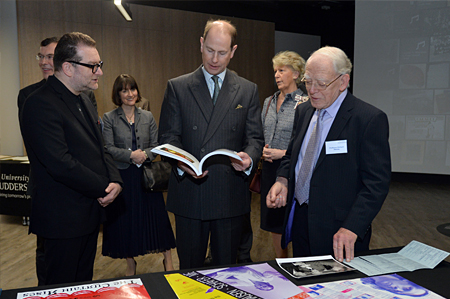 ► …. with Graham McKenzie (left) and Professor Richard Steinitz (right) from the Huddersfield Contemporary Music Festival
► …. with Graham McKenzie (left) and Professor Richard Steinitz (right) from the Huddersfield Contemporary Music Festival
One of The Earl’s destinations when he came to the campus was its award-winning archives centre, Heritage Quay – home to the British Music Collection, comprising over 40,000 scores and recordings.
Professor Robert Adlington, who holds the Queen’s Anniversary Prize Chair in Contemporary Music at the University, showed The Earl a selection of 20th century scores with Royal links. One was titled Cradle Song for a New Born Child, with music by Sir Arthur Bliss and words by Eric Crozier. It was composed in 1964 on the occasion of the Earl’s own birth, as Prince Edward.
Professor Adlington also played a recording of the piece, and The Earl was intrigued to hear it for the very first time.
While at Heritage Quay, he was introduced by Deputy Vice-Chancellor Professor Tim Thornton to some of the University’s professors of composition and to Emeritus Professor Richard Steinitz, who founded the famous Huddersfield Contemporary Music Festival, which has now reached its 40th year.
The Earl talked to the present Festival Director, Graham McKenzie, who told how it had become a global brand, staging events overseas.
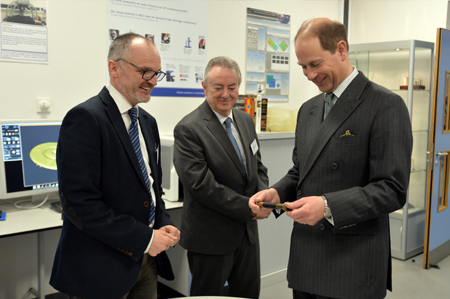 ◄ …. with Professor Liam Blunt (left), Director of the Centre for Precision Technologies
◄ …. with Professor Liam Blunt (left), Director of the Centre for Precision Technologies
When he arrived at the University, accompanied by the Lord Lieutenant of West Yorkshire, Dr Ingrid Roscoe, The Earl of Wessex entered its 3M Buckley Innovation Centre. Escorted by the University’s Vice-Chancellor, Professor Bob Cryan, he met the metrologist Professor Liam Blunt, Director of the Centre for Precision Technologies.
Professor Blunt described research in the field of forensic metrology, including a project to improve the accuracy rate in matching bullets to firearms. Despite the impression given by television shows, such as CSI, the procedure is currently far from infallible, The Earl was told, and the CPT’s research included the development of a new digital database and algorithm that would challenge U.S. dominance of the field.
The Earl also met Katie Addinall, who is carrying out doctoral research in bullet identification, and Professor Blunt described the role of surface metrology in the measurement of other complex components such as aero engine parts and replacement knee joints.
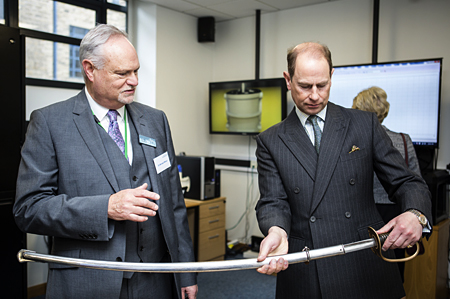 ► …. with Dr Michael Wilson (left), Technical Director of the University’s 3M Buckley Innovation Centre
► …. with Dr Michael Wilson (left), Technical Director of the University’s 3M Buckley Innovation Centre
When he visited the Visualisation and Modelling Suite at the 3M BIC, The Earl met Dr Michael Wilson, who is the Centre’s Technology Director. He told the Royal Visitor how the technique of X-ray fluorescence could be used for purposes that included verifying the authenticity of ancient artefacts such as weapons or silver coins.
For example, a genuine Roman coin would actually have quite a large lead content, whereas a modern counterfeit might be pure silver, but much less valuable. Dr Wilson showed how the analysis techniques in the lab could provide a graphic display of the metal content of coins and other items, such as historic weapons – aiding their valuation by auction houses and museums such as Royal Armouries. Other uses of the techniques included an analysis of replacement human joints, with the best-quality products being pure titanium, unlike cheaper counterfeits.
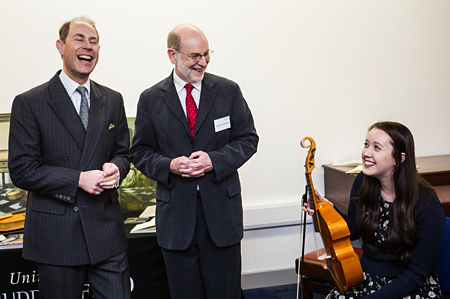 ◄ …. with Professor John Bryan (right) in the University’s Early Music Centre
◄ …. with Professor John Bryan (right) in the University’s Early Music Centre
The Earl also visited the University of Huddersfield’s Music Department, where he met the early music specialist Professor John Bryan, who has been researching the history of the viol, a bowed stringed instrument that was highly-prized during the Tudor period. Showing how he used sources such as art works to reconstruct the viol as it was some 500 years ago, Prof Bryan also introduced the Earl to a group of students who have been exploring the instrument’s playing technique.
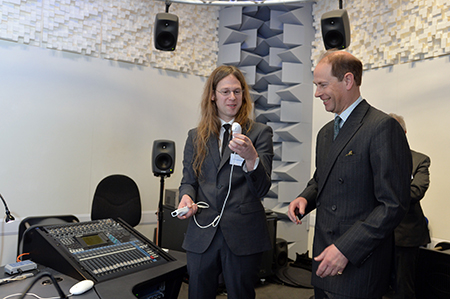 ► …. with Dr Frédéric Dufeu (left) in the SPIRAL Lab
► …. with Dr Frédéric Dufeu (left) in the SPIRAL Lab
The University’s Dean of Music, Humanities and Media, Professor Michael Clarke, took the Earl to the department’s Spatialisation and Interactive Research lab, known as SPIRAL, which has a 25-channel digital loudspeaker array. Its potential for creating shifting dimensions in sound and simulating a wide range of acoustics was demonstrated by Dr Frédéric Dufeu, Research Fellow in Music and Music Technology.
He showed how a Wii handset, normally used for computer gaming, could control SPIRAL and its soundscapes – and The Earl had a turn himself.
His final duty at the University was to unveil a plaque that marks the spot in the Creative Arts Building where a time capsule has been walled in, to be retrieved and opened in 25 years, when the University will mark the 200th anniversary of its founding institution.
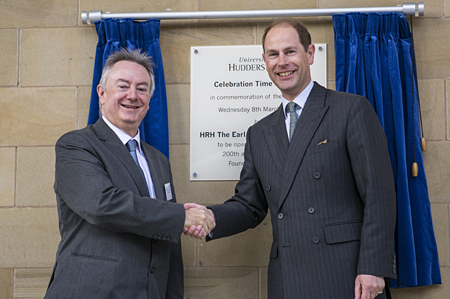 Introducing the short outdoor ceremony, Professor Cryan explained how the University had been marking its 175th anniversary, and the time capsule – containing items suggested by staff – was intended to cap the commemorations. The plaque unveiled by The Earl (pictured) was “to remind our successors to unearth the capsule and pore over its contents, touching and analysing some of the things that made the year 2016 distinctive,” said Professor Cryan.
Introducing the short outdoor ceremony, Professor Cryan explained how the University had been marking its 175th anniversary, and the time capsule – containing items suggested by staff – was intended to cap the commemorations. The plaque unveiled by The Earl (pictured) was “to remind our successors to unearth the capsule and pore over its contents, touching and analysing some of the things that made the year 2016 distinctive,” said Professor Cryan.
“Some of the material is disturbing, some of it uplifting. Some of the material is timeless. Some of it is very much of its time. The capsule is a digest of what was good, bad and controversial about this point in history,” he added.
After the ceremony and prior to departure, The Earl went on a walkabout of the University’s campus and chatted to students.
The party that accompanied him on his visit included the Mayor and Mayoress of Kirklees, Councillor Jim Dodds and the Mayoress, Carol Dodds. Also present was Chris Brown, who chairs the University’s Council and who is the current High Sheriff of West Yorkshire.







